Health-Illness Continuum: Understanding Personal State of Health
VerifiedAdded on 2023/04/25
|6
|1208
|295
AI Summary
The paper discusses the importance of the health-illness continuum in relation to health and caring for patients. It also reflects on personal state of health and provides options and resources to move towards wellness on the health-illness spectrum.
Contribute Materials
Your contribution can guide someone’s learning journey. Share your
documents today.

Running head: HEALTH-ILLNESS CONTINUUM
Health-illness continuum
Name of the student:
Name of the University:
Author’s note
Health-illness continuum
Name of the student:
Name of the University:
Author’s note
Secure Best Marks with AI Grader
Need help grading? Try our AI Grader for instant feedback on your assignments.
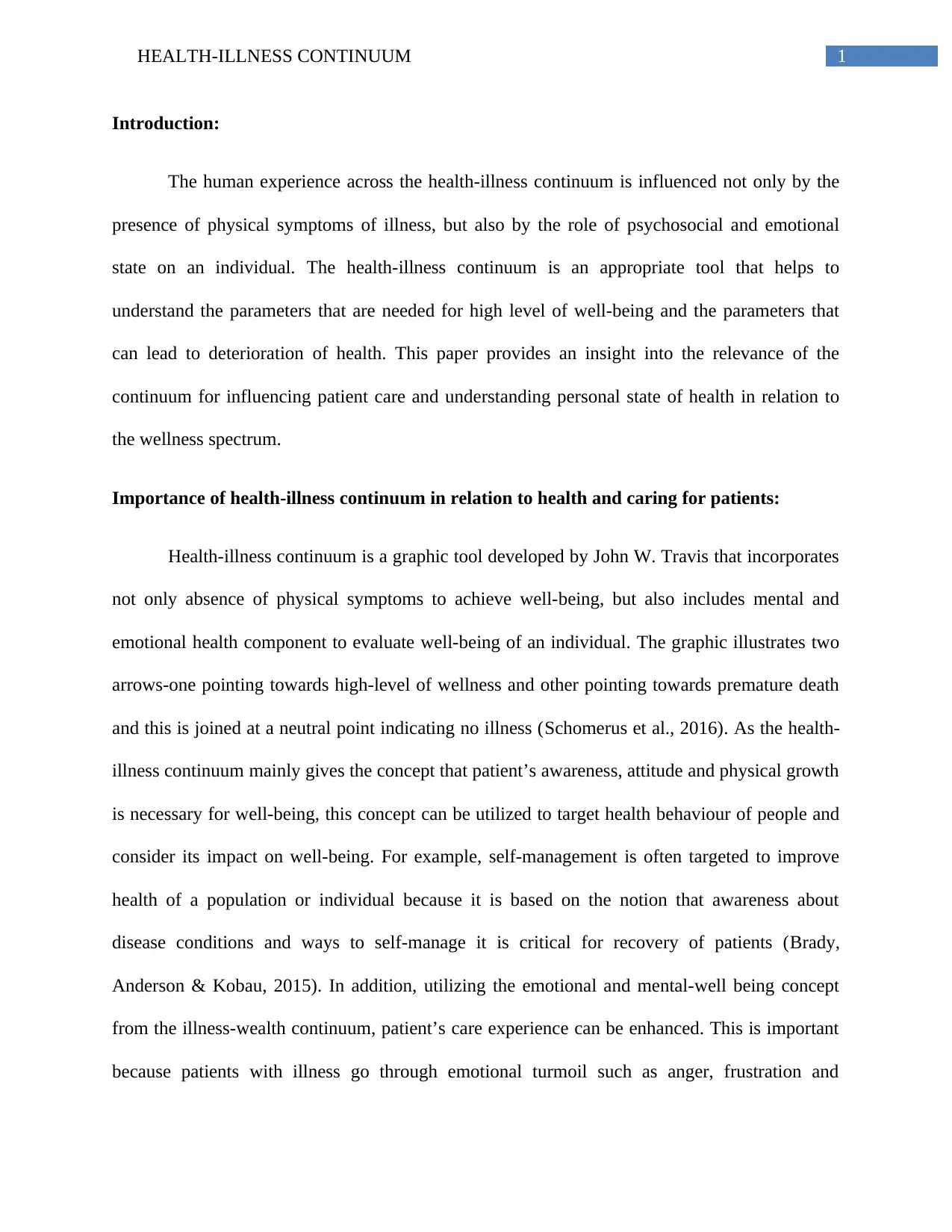
1HEALTH-ILLNESS CONTINUUM
Introduction:
The human experience across the health-illness continuum is influenced not only by the
presence of physical symptoms of illness, but also by the role of psychosocial and emotional
state on an individual. The health-illness continuum is an appropriate tool that helps to
understand the parameters that are needed for high level of well-being and the parameters that
can lead to deterioration of health. This paper provides an insight into the relevance of the
continuum for influencing patient care and understanding personal state of health in relation to
the wellness spectrum.
Importance of health-illness continuum in relation to health and caring for patients:
Health-illness continuum is a graphic tool developed by John W. Travis that incorporates
not only absence of physical symptoms to achieve well-being, but also includes mental and
emotional health component to evaluate well-being of an individual. The graphic illustrates two
arrows-one pointing towards high-level of wellness and other pointing towards premature death
and this is joined at a neutral point indicating no illness (Schomerus et al., 2016). As the health-
illness continuum mainly gives the concept that patient’s awareness, attitude and physical growth
is necessary for well-being, this concept can be utilized to target health behaviour of people and
consider its impact on well-being. For example, self-management is often targeted to improve
health of a population or individual because it is based on the notion that awareness about
disease conditions and ways to self-manage it is critical for recovery of patients (Brady,
Anderson & Kobau, 2015). In addition, utilizing the emotional and mental-well being concept
from the illness-wealth continuum, patient’s care experience can be enhanced. This is important
because patients with illness go through emotional turmoil such as anger, frustration and
Introduction:
The human experience across the health-illness continuum is influenced not only by the
presence of physical symptoms of illness, but also by the role of psychosocial and emotional
state on an individual. The health-illness continuum is an appropriate tool that helps to
understand the parameters that are needed for high level of well-being and the parameters that
can lead to deterioration of health. This paper provides an insight into the relevance of the
continuum for influencing patient care and understanding personal state of health in relation to
the wellness spectrum.
Importance of health-illness continuum in relation to health and caring for patients:
Health-illness continuum is a graphic tool developed by John W. Travis that incorporates
not only absence of physical symptoms to achieve well-being, but also includes mental and
emotional health component to evaluate well-being of an individual. The graphic illustrates two
arrows-one pointing towards high-level of wellness and other pointing towards premature death
and this is joined at a neutral point indicating no illness (Schomerus et al., 2016). As the health-
illness continuum mainly gives the concept that patient’s awareness, attitude and physical growth
is necessary for well-being, this concept can be utilized to target health behaviour of people and
consider its impact on well-being. For example, self-management is often targeted to improve
health of a population or individual because it is based on the notion that awareness about
disease conditions and ways to self-manage it is critical for recovery of patients (Brady,
Anderson & Kobau, 2015). In addition, utilizing the emotional and mental-well being concept
from the illness-wealth continuum, patient’s care experience can be enhanced. This is important
because patients with illness go through emotional turmoil such as anger, frustration and
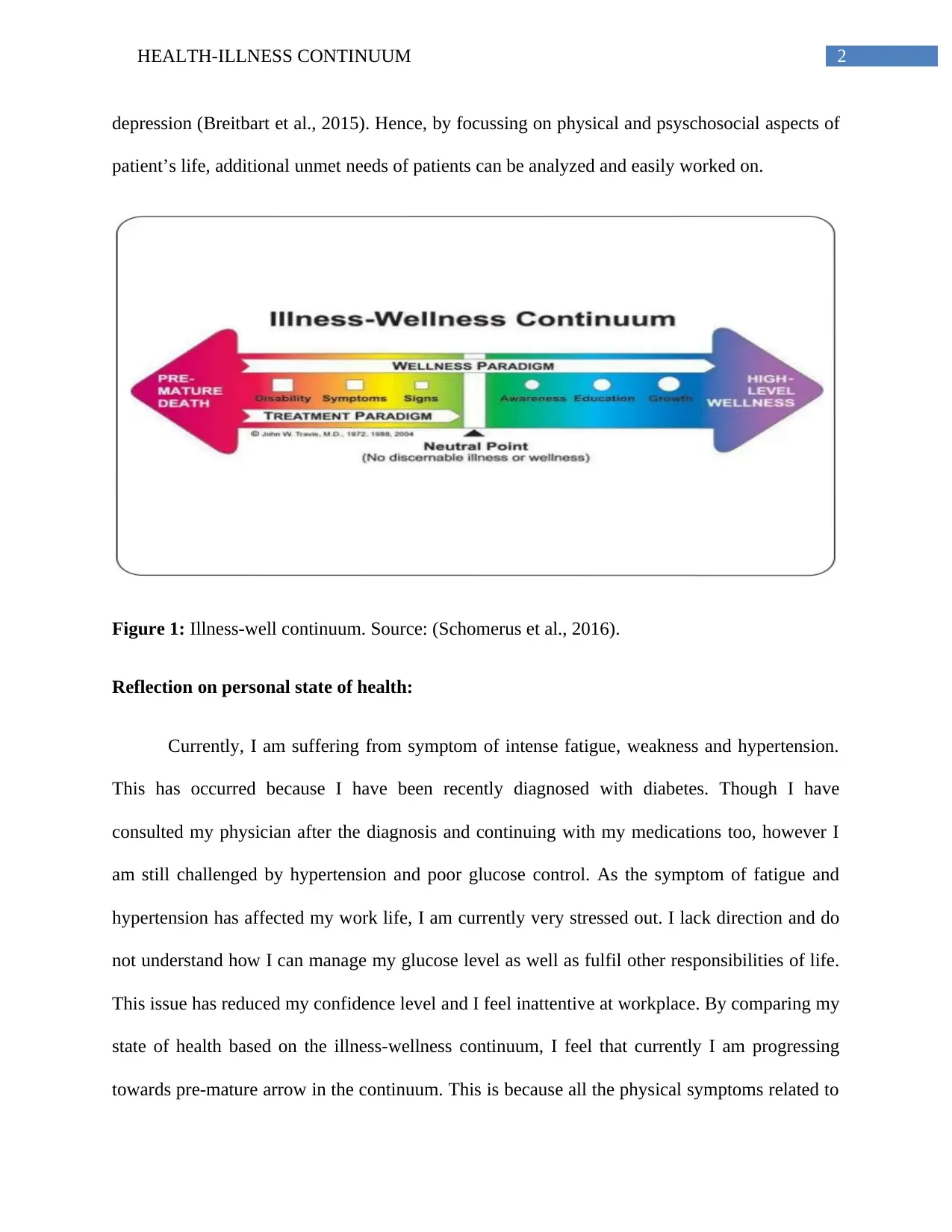
2HEALTH-ILLNESS CONTINUUM
depression (Breitbart et al., 2015). Hence, by focussing on physical and psyschosocial aspects of
patient’s life, additional unmet needs of patients can be analyzed and easily worked on.
Figure 1: Illness-well continuum. Source: (Schomerus et al., 2016).
Reflection on personal state of health:
Currently, I am suffering from symptom of intense fatigue, weakness and hypertension.
This has occurred because I have been recently diagnosed with diabetes. Though I have
consulted my physician after the diagnosis and continuing with my medications too, however I
am still challenged by hypertension and poor glucose control. As the symptom of fatigue and
hypertension has affected my work life, I am currently very stressed out. I lack direction and do
not understand how I can manage my glucose level as well as fulfil other responsibilities of life.
This issue has reduced my confidence level and I feel inattentive at workplace. By comparing my
state of health based on the illness-wellness continuum, I feel that currently I am progressing
towards pre-mature arrow in the continuum. This is because all the physical symptoms related to
depression (Breitbart et al., 2015). Hence, by focussing on physical and psyschosocial aspects of
patient’s life, additional unmet needs of patients can be analyzed and easily worked on.
Figure 1: Illness-well continuum. Source: (Schomerus et al., 2016).
Reflection on personal state of health:
Currently, I am suffering from symptom of intense fatigue, weakness and hypertension.
This has occurred because I have been recently diagnosed with diabetes. Though I have
consulted my physician after the diagnosis and continuing with my medications too, however I
am still challenged by hypertension and poor glucose control. As the symptom of fatigue and
hypertension has affected my work life, I am currently very stressed out. I lack direction and do
not understand how I can manage my glucose level as well as fulfil other responsibilities of life.
This issue has reduced my confidence level and I feel inattentive at workplace. By comparing my
state of health based on the illness-wellness continuum, I feel that currently I am progressing
towards pre-mature arrow in the continuum. This is because all the physical symptoms related to
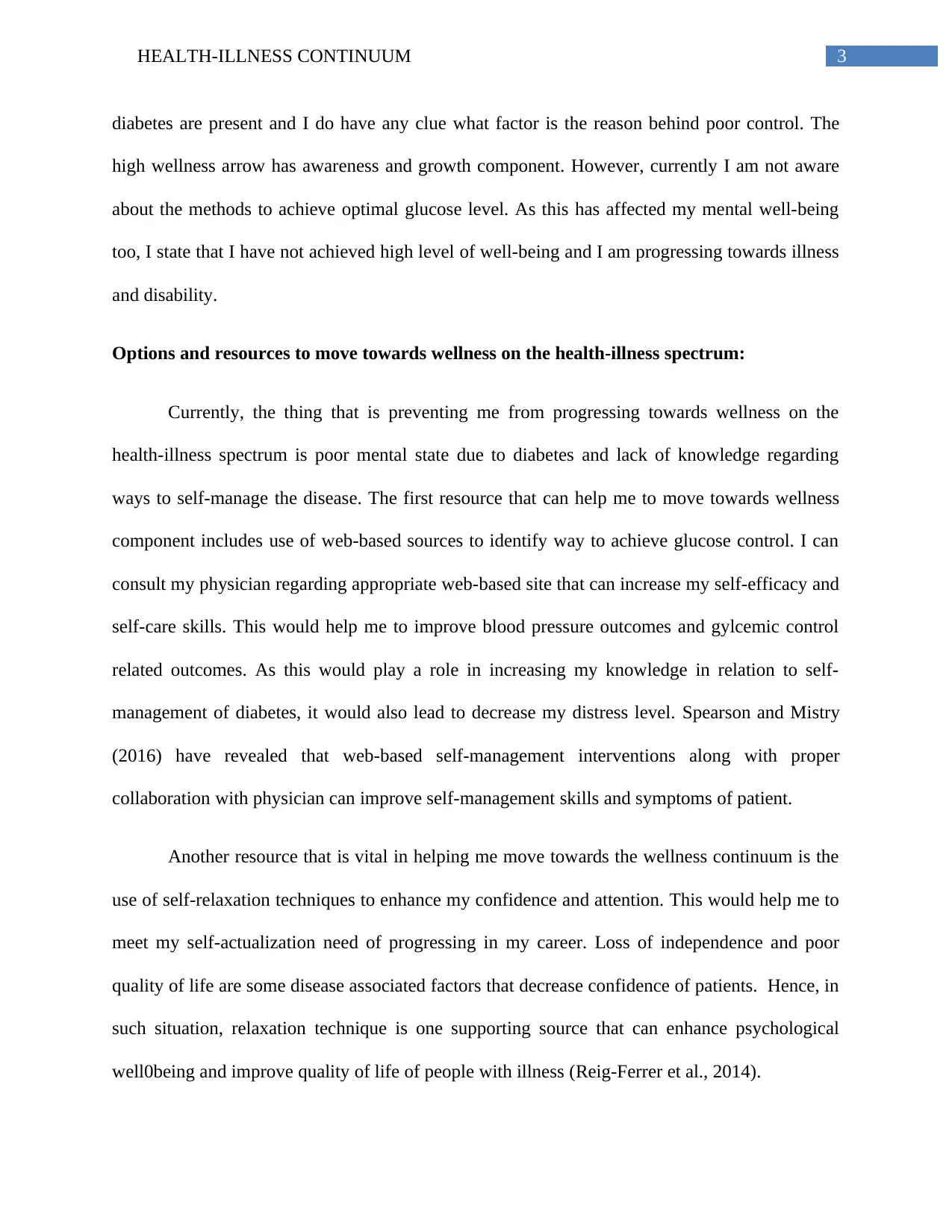
3HEALTH-ILLNESS CONTINUUM
diabetes are present and I do have any clue what factor is the reason behind poor control. The
high wellness arrow has awareness and growth component. However, currently I am not aware
about the methods to achieve optimal glucose level. As this has affected my mental well-being
too, I state that I have not achieved high level of well-being and I am progressing towards illness
and disability.
Options and resources to move towards wellness on the health-illness spectrum:
Currently, the thing that is preventing me from progressing towards wellness on the
health-illness spectrum is poor mental state due to diabetes and lack of knowledge regarding
ways to self-manage the disease. The first resource that can help me to move towards wellness
component includes use of web-based sources to identify way to achieve glucose control. I can
consult my physician regarding appropriate web-based site that can increase my self-efficacy and
self-care skills. This would help me to improve blood pressure outcomes and gylcemic control
related outcomes. As this would play a role in increasing my knowledge in relation to self-
management of diabetes, it would also lead to decrease my distress level. Spearson and Mistry
(2016) have revealed that web-based self-management interventions along with proper
collaboration with physician can improve self-management skills and symptoms of patient.
Another resource that is vital in helping me move towards the wellness continuum is the
use of self-relaxation techniques to enhance my confidence and attention. This would help me to
meet my self-actualization need of progressing in my career. Loss of independence and poor
quality of life are some disease associated factors that decrease confidence of patients. Hence, in
such situation, relaxation technique is one supporting source that can enhance psychological
well0being and improve quality of life of people with illness (Reig-Ferrer et al., 2014).
diabetes are present and I do have any clue what factor is the reason behind poor control. The
high wellness arrow has awareness and growth component. However, currently I am not aware
about the methods to achieve optimal glucose level. As this has affected my mental well-being
too, I state that I have not achieved high level of well-being and I am progressing towards illness
and disability.
Options and resources to move towards wellness on the health-illness spectrum:
Currently, the thing that is preventing me from progressing towards wellness on the
health-illness spectrum is poor mental state due to diabetes and lack of knowledge regarding
ways to self-manage the disease. The first resource that can help me to move towards wellness
component includes use of web-based sources to identify way to achieve glucose control. I can
consult my physician regarding appropriate web-based site that can increase my self-efficacy and
self-care skills. This would help me to improve blood pressure outcomes and gylcemic control
related outcomes. As this would play a role in increasing my knowledge in relation to self-
management of diabetes, it would also lead to decrease my distress level. Spearson and Mistry
(2016) have revealed that web-based self-management interventions along with proper
collaboration with physician can improve self-management skills and symptoms of patient.
Another resource that is vital in helping me move towards the wellness continuum is the
use of self-relaxation techniques to enhance my confidence and attention. This would help me to
meet my self-actualization need of progressing in my career. Loss of independence and poor
quality of life are some disease associated factors that decrease confidence of patients. Hence, in
such situation, relaxation technique is one supporting source that can enhance psychological
well0being and improve quality of life of people with illness (Reig-Ferrer et al., 2014).
Paraphrase This Document
Need a fresh take? Get an instant paraphrase of this document with our AI Paraphraser
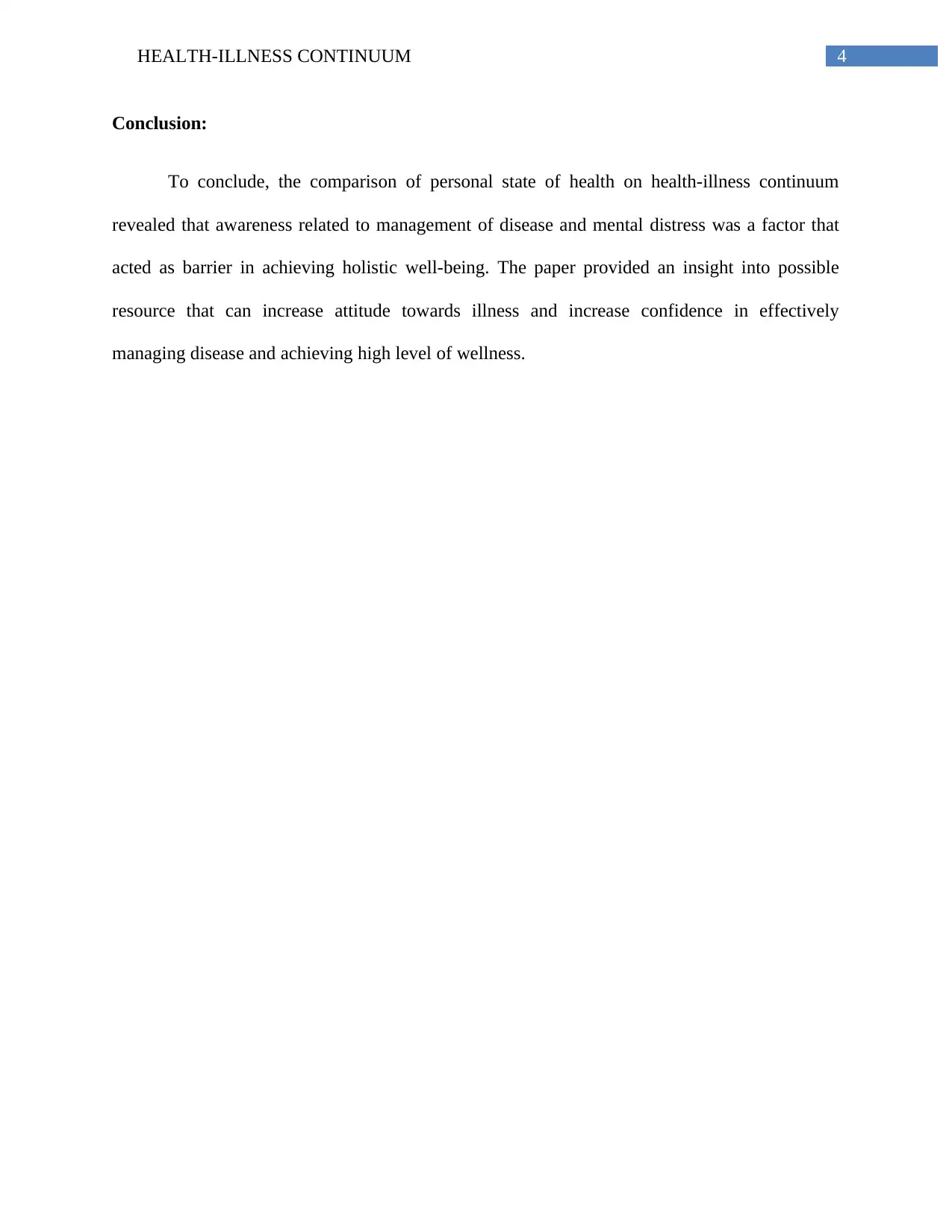
4HEALTH-ILLNESS CONTINUUM
Conclusion:
To conclude, the comparison of personal state of health on health-illness continuum
revealed that awareness related to management of disease and mental distress was a factor that
acted as barrier in achieving holistic well-being. The paper provided an insight into possible
resource that can increase attitude towards illness and increase confidence in effectively
managing disease and achieving high level of wellness.
Conclusion:
To conclude, the comparison of personal state of health on health-illness continuum
revealed that awareness related to management of disease and mental distress was a factor that
acted as barrier in achieving holistic well-being. The paper provided an insight into possible
resource that can increase attitude towards illness and increase confidence in effectively
managing disease and achieving high level of wellness.
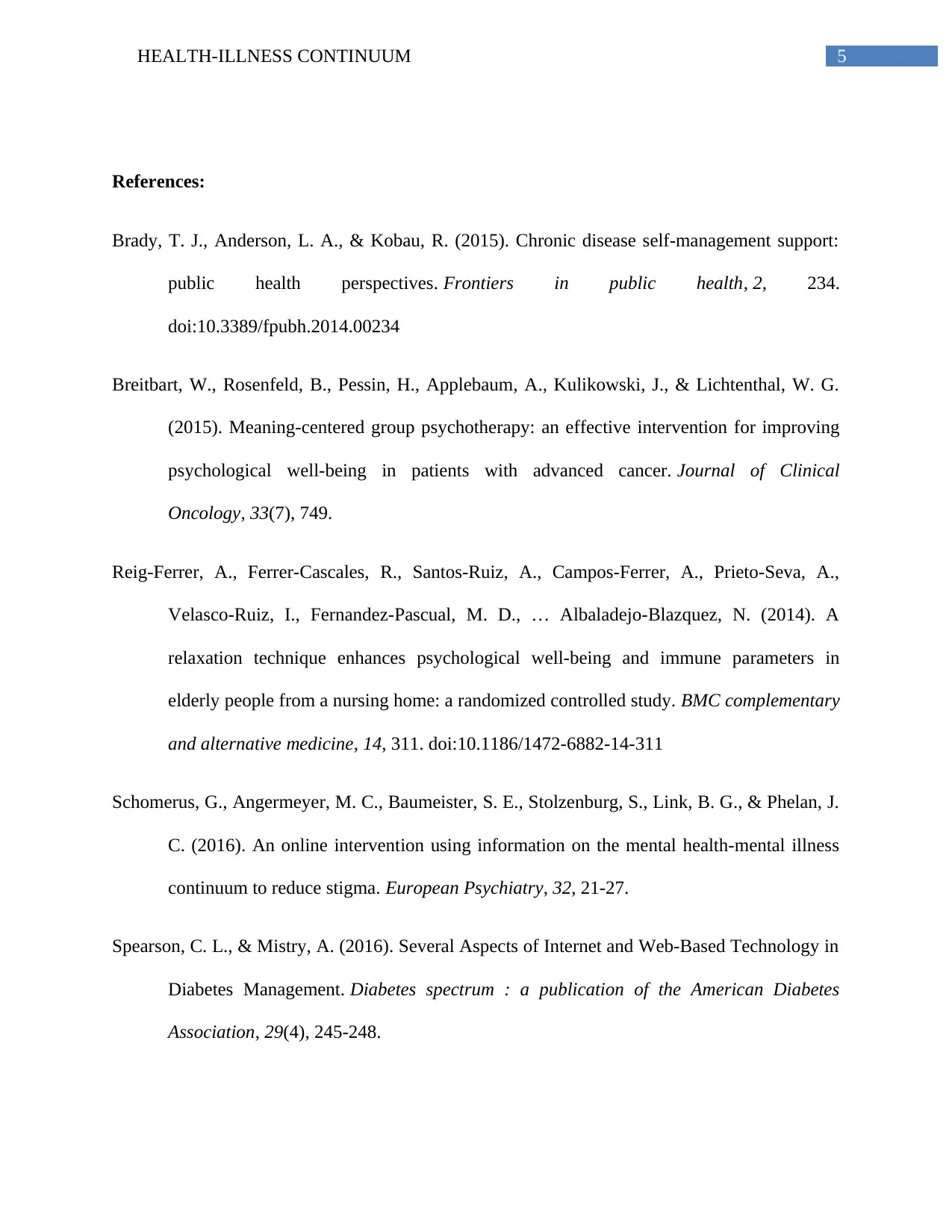
5HEALTH-ILLNESS CONTINUUM
References:
Brady, T. J., Anderson, L. A., & Kobau, R. (2015). Chronic disease self-management support:
public health perspectives. Frontiers in public health, 2, 234.
doi:10.3389/fpubh.2014.00234
Breitbart, W., Rosenfeld, B., Pessin, H., Applebaum, A., Kulikowski, J., & Lichtenthal, W. G.
(2015). Meaning-centered group psychotherapy: an effective intervention for improving
psychological well-being in patients with advanced cancer. Journal of Clinical
Oncology, 33(7), 749.
Reig-Ferrer, A., Ferrer-Cascales, R., Santos-Ruiz, A., Campos-Ferrer, A., Prieto-Seva, A.,
Velasco-Ruiz, I., Fernandez-Pascual, M. D., … Albaladejo-Blazquez, N. (2014). A
relaxation technique enhances psychological well-being and immune parameters in
elderly people from a nursing home: a randomized controlled study. BMC complementary
and alternative medicine, 14, 311. doi:10.1186/1472-6882-14-311
Schomerus, G., Angermeyer, M. C., Baumeister, S. E., Stolzenburg, S., Link, B. G., & Phelan, J.
C. (2016). An online intervention using information on the mental health-mental illness
continuum to reduce stigma. European Psychiatry, 32, 21-27.
Spearson, C. L., & Mistry, A. (2016). Several Aspects of Internet and Web-Based Technology in
Diabetes Management. Diabetes spectrum : a publication of the American Diabetes
Association, 29(4), 245-248.
References:
Brady, T. J., Anderson, L. A., & Kobau, R. (2015). Chronic disease self-management support:
public health perspectives. Frontiers in public health, 2, 234.
doi:10.3389/fpubh.2014.00234
Breitbart, W., Rosenfeld, B., Pessin, H., Applebaum, A., Kulikowski, J., & Lichtenthal, W. G.
(2015). Meaning-centered group psychotherapy: an effective intervention for improving
psychological well-being in patients with advanced cancer. Journal of Clinical
Oncology, 33(7), 749.
Reig-Ferrer, A., Ferrer-Cascales, R., Santos-Ruiz, A., Campos-Ferrer, A., Prieto-Seva, A.,
Velasco-Ruiz, I., Fernandez-Pascual, M. D., … Albaladejo-Blazquez, N. (2014). A
relaxation technique enhances psychological well-being and immune parameters in
elderly people from a nursing home: a randomized controlled study. BMC complementary
and alternative medicine, 14, 311. doi:10.1186/1472-6882-14-311
Schomerus, G., Angermeyer, M. C., Baumeister, S. E., Stolzenburg, S., Link, B. G., & Phelan, J.
C. (2016). An online intervention using information on the mental health-mental illness
continuum to reduce stigma. European Psychiatry, 32, 21-27.
Spearson, C. L., & Mistry, A. (2016). Several Aspects of Internet and Web-Based Technology in
Diabetes Management. Diabetes spectrum : a publication of the American Diabetes
Association, 29(4), 245-248.
1 out of 6
![[object Object]](/_next/static/media/star-bottom.7253800d.svg)




